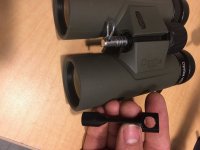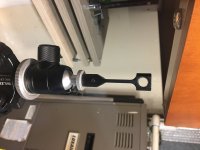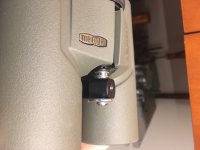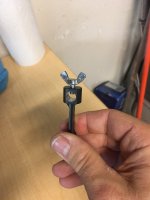I have to first thank Nrolson2002 and 16Bore for inspiring ideas on how to lighten my optics load backpacking and still feel a tripod is worth the weight to bring along.
I started out with a few stock adaptors laying around but none were ideal and as lightweight and fast as I would have preferred.
In an attempt to not waste any more money, I re-utilized a vortex uni-adaptor to suite my needs.
The uni-adaptor was a nice setup to start with I will admit, but the bottom of the adapter was starting to pile and presumably eventually tear the inside of my bino harness pack.
Anyhow heres the skinny;
Parts needed (besides the uni-adaptor, or any similar strut type adaptor) :
qty 1 5/16" x 1 1/4" clevis pin
qty 1 5/16" hair pin
qty 1 5/16" spring
Using a 5/16" drill bit, bore the inside of the uni-adaptor out to 5/16"
Cut the head off the clevis pin and thread the end to 1/4"-20 threads
Thread the clevis onto your binos. Be sure its tight, you dont want to lose it out in the field
Cut the spring (if needed) to about 3/8" long
Put a slight inward bend on the last loop of the spring with needle nose pliers so it stays on the clevis pin by interference fit.
Slide the spring onto the clevis pin
Done
You have a few options here.
You may either toss or keep the original base for the uni-adaptor to use for your tripod. For the least weight, toss it, as its not needed.
The spring is not necessarily needed, but it purpose is to keep the binos tight in the adaptor but still allow them to rotate clock/counterclockwise as needed.
Optional is of course is an arca plate for your tripod, but that depends on your individual base mounting needs
If you lack the tools to cut and thread a clevis pin, you can use a pin/bolt already threaded 1/4"x20 and drill a hole at the end for the hair pin.
You also have the option of using a magnet at the end of the clevis pin instead of a hair pin. Not as quite as secure, but a touch faster.
You also have the option of using a cotterless clevis pin ( as suggested by 16Bore) instead of the hole/hair pin method, but a spring is definitely needed in that case to hold things tight.
And last, you have the option of drilling and threading a hole in the top of the uni-adaptor to install a wingnut to fully lock down the binos if you want. I originally started with this option, but after using the pin/hair pin method I found it was not needed.
Weight. With my setup, my tripod, ball head, and bino adaptor come in at 2lbs, 3oz.
I started out with a few stock adaptors laying around but none were ideal and as lightweight and fast as I would have preferred.
In an attempt to not waste any more money, I re-utilized a vortex uni-adaptor to suite my needs.
The uni-adaptor was a nice setup to start with I will admit, but the bottom of the adapter was starting to pile and presumably eventually tear the inside of my bino harness pack.
Anyhow heres the skinny;
Parts needed (besides the uni-adaptor, or any similar strut type adaptor) :
qty 1 5/16" x 1 1/4" clevis pin
qty 1 5/16" hair pin
qty 1 5/16" spring
Using a 5/16" drill bit, bore the inside of the uni-adaptor out to 5/16"
Cut the head off the clevis pin and thread the end to 1/4"-20 threads
Thread the clevis onto your binos. Be sure its tight, you dont want to lose it out in the field
Cut the spring (if needed) to about 3/8" long
Put a slight inward bend on the last loop of the spring with needle nose pliers so it stays on the clevis pin by interference fit.
Slide the spring onto the clevis pin
Done
You have a few options here.
You may either toss or keep the original base for the uni-adaptor to use for your tripod. For the least weight, toss it, as its not needed.
The spring is not necessarily needed, but it purpose is to keep the binos tight in the adaptor but still allow them to rotate clock/counterclockwise as needed.
Optional is of course is an arca plate for your tripod, but that depends on your individual base mounting needs
If you lack the tools to cut and thread a clevis pin, you can use a pin/bolt already threaded 1/4"x20 and drill a hole at the end for the hair pin.
You also have the option of using a magnet at the end of the clevis pin instead of a hair pin. Not as quite as secure, but a touch faster.
You also have the option of using a cotterless clevis pin ( as suggested by 16Bore) instead of the hole/hair pin method, but a spring is definitely needed in that case to hold things tight.
And last, you have the option of drilling and threading a hole in the top of the uni-adaptor to install a wingnut to fully lock down the binos if you want. I originally started with this option, but after using the pin/hair pin method I found it was not needed.
Weight. With my setup, my tripod, ball head, and bino adaptor come in at 2lbs, 3oz.





